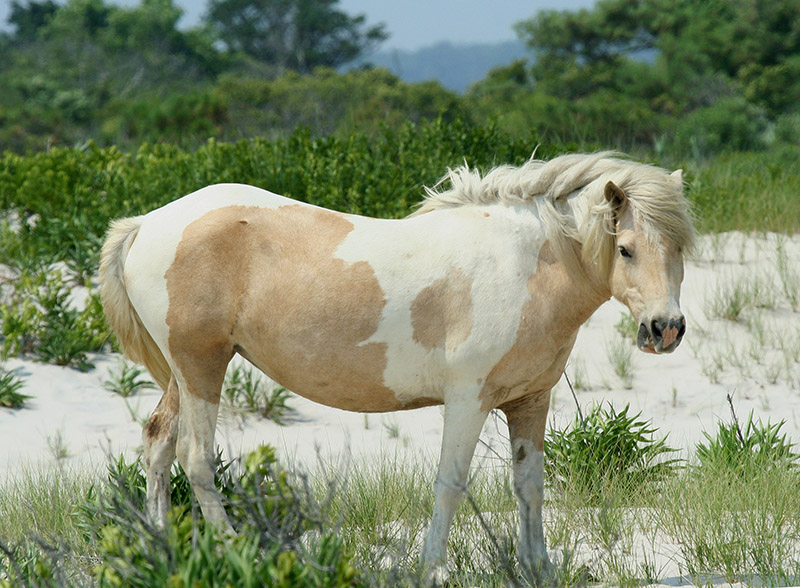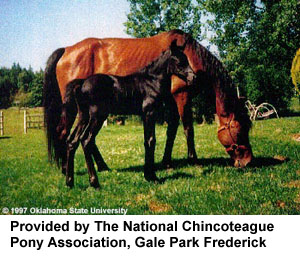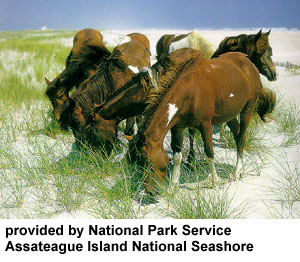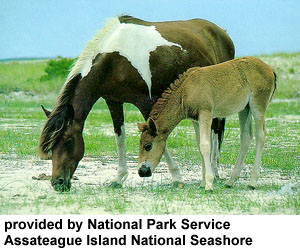Chincoteague Pony
 The Chincoteague Pony, now a registered breed, descends from the 'wild' horses on
Assateague Island, a 37 mile long barrier island off the coast of Maryland and Virginia.
The 'wild' horses on Assateague are actually feral animals, meaning that they are
descendants of domestic animals that have reverted to a wild state.
The Chincoteague Pony, now a registered breed, descends from the 'wild' horses on
Assateague Island, a 37 mile long barrier island off the coast of Maryland and Virginia.
The 'wild' horses on Assateague are actually feral animals, meaning that they are
descendants of domestic animals that have reverted to a wild state.
Despite the often told tale of the horses swimming to Assateague from a shipwrecked Spanish galleon, the most plausible explanation is that they are the descendents of horses that were brought to Assateague in the 17th century by mainland owners to avoid fencing laws and taxation of livestock.
Today's horses are actually the size of ponies (average 12- 13 hands) probably due to their poor diet and harsh environment. Some horses removed from Assateague as foals and fed a higher protein diet grow to horse size. Almost 80% of their diet is coarse saltmarsh cordgrass and American beachgrass. Various grass species, greenbrier stems, bayberry twigs, rose hips, seaweeds and poison ivy make up the rest of their diet. The high concentration of salt in their diets causes the horses to drink twice as much fresh water as domestic horses. Because of this, the horses have a "fat" or "bloated" appearance. Although they will sip salt water, they actually drink very little of it.
The ponies are split into two main herds, one on the Virginia end and one on the Maryland end of Assateague. A fence at the Virginia/Maryland State line separates the herds and the population size of each herd is kept around 150 animals to lessen their impact on island ecology. These herds have divided themselves into bands of two to twelve animals and each band occupies a home range.
The National Park Service owns and manages the Maryland herd. The Chincoteague Volunteer Fire Company owns and manages the Virginia Herd, which is allowed to graze on Chincoteague National Wildlife Refuge, through a special use permit issued by the U.S. Fish and Wildlife Service. The permit restricts the size of the herd to approximately 150 adult animals in order to protect the other natural resources of the wildlife refuge. It is the Virginia herd that is often referred to as the "Chincoteague" ponies.
The herds are managed differently. In Virginia, the internationally famous "Pony Penning" event is responsible for meeting the limit of 150 adult animals. This event began in some form during the 17th century when unclaimed horses were captured and marked by colonists in the presence of neighbors on a day of fellowship and festivity. The modem Pony Penning began in 1924 as an effort to raise money for the Chincoteague Volunteer Fire Company and is still held on the last Wednesday and Thursday of July. The Virginia herd, rounded up by the Chincoteague "saltwater cowboys", swims across the channel (at slack tide) to Chincoteague on Wednesday in front of thousands of cheering spectators. The swim takes about 5 - 10 minutes. Most of the foals are auctioned off on Thursday and the remaining horses swim back to Assateague on Friday. New owners must be able to provide safe, humane transportation for their purchases. Most foals are easily tamed and adapt well to domestic life. The Virginia herd undergoes a veterinarian check twice a year. In the spring (April) they are vaccinated against encephalitis (both eastern and western strain), rabies and tetanus and tested for EIA (Equine Infectious Anemia or swamp fever). They are also dewormed and some horses have their hooves trimmed. In the fall they are dewormed again and all horses have their hooves trimmed. The horses on the Virginia side of the island are also fenced off from road areas to stop people from feeding them and attracting them to cars and roadways, where they have been fatally injured in the past.
In Maryland, the number of horses has grown from approximately 28 in 1968 to more than 165 in 1997, exceeding the desired herd size of 120 to 150 animals. With this growth has come increasing evidence that the horses are having a significant negative impact on the dune and salt marsh habitats due to overgrazing. By establishing a population limit of 120 to 150 animals, the National Park Service is attempting to balance the health and well being of the horses with the need to protect the island's other sensitive natural resources and values. To manage population growth on a long-term basis, a unique contraceptive has been developed for use in the Maryland herd. Administered by dart guns, the non-hormonal contraceptive vaccine stimulates the horse's immune system to produce antibodies. At sufficiently high levels these antibodies block fertilization and thereby prevent pregnancy. The contraceptive effect is temporary, lasting about one year, but can be extended with an annual booster shot. During seven years of experimental field trials, the technique has proven better than 95% effective and has exhibited no harmful side effects. Use of the contraceptive as part of a long-term horse population management program began in 1994.
For registry information please contact: The National Chincoteague Pony Association, Gale Park Frederick, 2595 Jensen Road, Bellingham, Washington 98226 Phone: (360) 671-8338
References
National Park Service, Assateague Island National Seashore, 7206 National Seashore Lane, Berlin, Maryland 21811
Phone: (410) 641-1441
Chincoteague Pony GalleryTake a closer look at the Chincoteague Pony breed.








